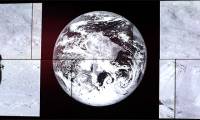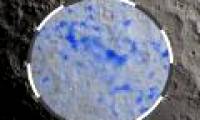
Over the past two decades, research on the Moon has revealed the rich resources on Earth's natural satellite.

After discovering the amount of carbon emissions emanating from all over the lunar surface, a new study could rewrite experts' knowledge of the lunar formation.

Analyzing dust sticking on astronauts' gloves, the researchers found iron, water and helium in moon dust.

The latest information was sent by NASA's Lunar Reconnaissance Orbiter, a network of lava tubes beneath the moon's surface.

The image of the Moon's surface in 1968 taken by Lunar Orbiter has just appeared online, causing a wave of controversy.

US scientists discovered on the Moon that the atmosphere existed about 3 to 4 billion years ago, Futurism reported on October 7.

Recently, experts from Brown University (Rhode Island, USA) have found evidence that the Moon may contain a huge amount of water inside volcanic glass layers.

Lava caves beneath the Moon's surface with a diameter of up to 5 km can protect people from extreme temperatures, radiation and meteorite collisions.

According to the exploration of the Hang Nga 3 ship (China), there is no water on the Moon as many people hope.
 Over the past two decades, research on the Moon has revealed the rich resources on Earth's natural satellite.
Over the past two decades, research on the Moon has revealed the rich resources on Earth's natural satellite. After discovering the amount of carbon emissions emanating from all over the lunar surface, a new study could rewrite experts' knowledge of the lunar formation.
After discovering the amount of carbon emissions emanating from all over the lunar surface, a new study could rewrite experts' knowledge of the lunar formation. Analyzing dust sticking on astronauts' gloves, the researchers found iron, water and helium in moon dust.
Analyzing dust sticking on astronauts' gloves, the researchers found iron, water and helium in moon dust. The latest information was sent by NASA's Lunar Reconnaissance Orbiter, a network of lava tubes beneath the moon's surface.
The latest information was sent by NASA's Lunar Reconnaissance Orbiter, a network of lava tubes beneath the moon's surface. The image of the Moon's surface in 1968 taken by Lunar Orbiter has just appeared online, causing a wave of controversy.
The image of the Moon's surface in 1968 taken by Lunar Orbiter has just appeared online, causing a wave of controversy. US scientists discovered on the Moon that the atmosphere existed about 3 to 4 billion years ago, Futurism reported on October 7.
US scientists discovered on the Moon that the atmosphere existed about 3 to 4 billion years ago, Futurism reported on October 7. Recently, experts from Brown University (Rhode Island, USA) have found evidence that the Moon may contain a huge amount of water inside volcanic glass layers.
Recently, experts from Brown University (Rhode Island, USA) have found evidence that the Moon may contain a huge amount of water inside volcanic glass layers. Lava caves beneath the Moon's surface with a diameter of up to 5 km can protect people from extreme temperatures, radiation and meteorite collisions.
Lava caves beneath the Moon's surface with a diameter of up to 5 km can protect people from extreme temperatures, radiation and meteorite collisions. According to the exploration of the Hang Nga 3 ship (China), there is no water on the Moon as many people hope.
According to the exploration of the Hang Nga 3 ship (China), there is no water on the Moon as many people hope.








 Why did the ancient Babylonian civilization perish? Was it because they considered 'that thing' a daily meal?
Why did the ancient Babylonian civilization perish? Was it because they considered 'that thing' a daily meal? Just discovered a 72km 'tear in the Earth', the world's second largest country is in fear of a tsunami attack
Just discovered a 72km 'tear in the Earth', the world's second largest country is in fear of a tsunami attack Top 7 facts about the hottest place in the world, where you can fry eggs at outdoor temperature
Top 7 facts about the hottest place in the world, where you can fry eggs at outdoor temperature The Qing Dynasty collapsed, what surname did 20,000 royal descendants change to to integrate into the new era?
The Qing Dynasty collapsed, what surname did 20,000 royal descendants change to to integrate into the new era? After 389 days in the Arctic, costing more than $160 million, hundreds of scientists brought back bad news: What was it?
After 389 days in the Arctic, costing more than $160 million, hundreds of scientists brought back bad news: What was it? How long does it take to fall in love with someone?
How long does it take to fall in love with someone? How much silver has ever been discovered in the world?
How much silver has ever been discovered in the world? How does an atomic bomb work?
How does an atomic bomb work?